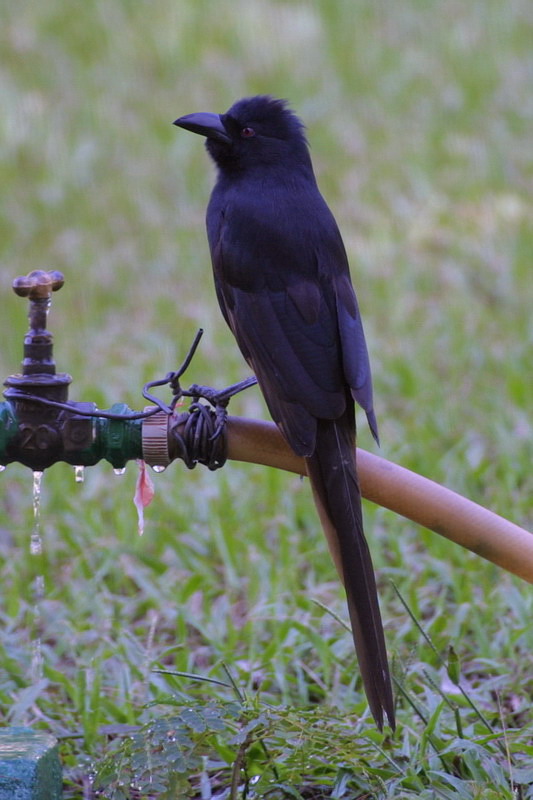m |
|||
| Line 1: | Line 1: | ||
| − | + | ||
;Ptilostomus afer | ;Ptilostomus afer | ||
| − | [[Image:Piapiac.jpg|thumb| | + | [[Image:Piapiac.jpg|thumb|550px|right|Photo by IanE]] |
| + | |||
| + | ==Identification== | ||
| + | In size it is a little smaller and slimmer than the European Magpie (Pica pica) though the bill is relatively thicker. The overall colouring of the bird is black with the feathers quite silky in texture and having a purplish gloss in good light. The base of the tail tends to be more brown in colour than the rest of the body. The nasal plumes are somewhat upturned on top of the bill but fully cover the nostrils. The bill itself is black in the adult but partly reddish-pink towards the base in juvenile specimens. Legs and feet are black. Iris is variable but tends towards violet, purple or mauve with a bluish-purple outer ring. | ||
| + | ==Distribution== | ||
| + | The range of the species is the tropical equatorial region of central Africa from Senegal on the west coast, eastwards in a broad band to Sudan and southern Ethiopia. | ||
| + | ==Taxonomy== | ||
| + | The Piapiac (Ptilostomus afer) is a member of the crow family, and is the only member of the genus Ptilostomus. According to recent findings, it is most closely related to the Central Asian ground jays (Ericson et al., 2005). | ||
| + | ==Habitat== | ||
| + | Within this range, its favoured habitat is towards more open country of cultivated land with fields and pasture and small associated towns and villages. | ||
| + | ==Behaviour== | ||
| + | Food is obtained in flocks of ten or more birds moving together on the ground including insects and other invertebrates but will take a degree of carrion, possibly attracted as much by the associated insects this attracts as much as the meat itself. Some fruit is also taken in trees with the oily fruit of the Oil Palm Elaeis guineensis a favourite. Able to run fast with some agility, it tends to hop at slower speed and will catch insects disturbed by the feet of cattle, sometimes hitching a ride on their backs and darting out to catch the prey. | ||
| + | |||
| + | Nesting is quite often in a palm tree, though other types are used also. Strips of palm leaf and grass stems are cemented together with mud and lined with palm fibre to form a cup. Three to seven eggs are laid and are very pale blue or greenish-blue with a few brown blotches from March to April. | ||
| + | |||
| + | The voice is usually described as a shrill squeaking often with the Jackdaw-like overtones. There is also a croaking alarm call given in anger where the head bobs. | ||
| + | |||
| + | |||
==External Links== | ==External Links== | ||
*[http://www.birdforum.net/pp_gallery/showgallery.php?mcats=all&what=allfields&si=Ptilostomus+afer+ View more images of Piapiac in the gallery] | *[http://www.birdforum.net/pp_gallery/showgallery.php?mcats=all&what=allfields&si=Ptilostomus+afer+ View more images of Piapiac in the gallery] | ||
[[Category:Birds]] | [[Category:Birds]] | ||
Revision as of 16:36, 23 July 2007
- Ptilostomus afer
Identification
In size it is a little smaller and slimmer than the European Magpie (Pica pica) though the bill is relatively thicker. The overall colouring of the bird is black with the feathers quite silky in texture and having a purplish gloss in good light. The base of the tail tends to be more brown in colour than the rest of the body. The nasal plumes are somewhat upturned on top of the bill but fully cover the nostrils. The bill itself is black in the adult but partly reddish-pink towards the base in juvenile specimens. Legs and feet are black. Iris is variable but tends towards violet, purple or mauve with a bluish-purple outer ring.
Distribution
The range of the species is the tropical equatorial region of central Africa from Senegal on the west coast, eastwards in a broad band to Sudan and southern Ethiopia.
Taxonomy
The Piapiac (Ptilostomus afer) is a member of the crow family, and is the only member of the genus Ptilostomus. According to recent findings, it is most closely related to the Central Asian ground jays (Ericson et al., 2005).
Habitat
Within this range, its favoured habitat is towards more open country of cultivated land with fields and pasture and small associated towns and villages.
Behaviour
Food is obtained in flocks of ten or more birds moving together on the ground including insects and other invertebrates but will take a degree of carrion, possibly attracted as much by the associated insects this attracts as much as the meat itself. Some fruit is also taken in trees with the oily fruit of the Oil Palm Elaeis guineensis a favourite. Able to run fast with some agility, it tends to hop at slower speed and will catch insects disturbed by the feet of cattle, sometimes hitching a ride on their backs and darting out to catch the prey.
Nesting is quite often in a palm tree, though other types are used also. Strips of palm leaf and grass stems are cemented together with mud and lined with palm fibre to form a cup. Three to seven eggs are laid and are very pale blue or greenish-blue with a few brown blotches from March to April.
The voice is usually described as a shrill squeaking often with the Jackdaw-like overtones. There is also a croaking alarm call given in anger where the head bobs.




